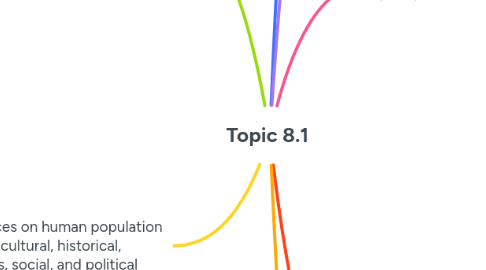
1. Implications of human population growth
1.1. More people will required
1.1.1. More food
1.1.2. More Water
1.1.3. More energy consumption + material goods
1.1.4. More waste + More pollution
2. influences on human population include cultural, historical, religious, social, and political
2.1. eg: decision to have large familities
2.1.1. Form of securtiy agianst high mortiality rate
2.1.2. security in having kids at an old age
2.1.3. Women are only seen has child bearers
2.1.3.1. Solutations
2.1.3.1.1. Provide education
2.1.3.1.2. Improve health
2.1.3.1.3. Greater access to contraceptives
2.1.3.1.4. Improve resource management
2.1.4. Children are an economic asset
2.1.5. unavailabilty of contraceptives
3. Demographic
3.1. statistical study of human populations & subgroups within dynamics through space & time
4. How to measure population change
4.1. Crude Death Rate
4.1.1. CDR = (death/total population) x 1000
4.2. Crude Birth Rate
4.2.1. CBR = (birth/total population) x 1000
4.3. Natural Increase Rate
4.3.1. (CBD-CBR) / 10
4.4. Doubling Time
4.4.1. 70/NIR
4.5. Total Fertility Rate
4.5.1. The total fertility rate of a population is the average number of children that would be born to a woman over her life
4.6. General Fertility Rate
4.6.1. # yearly registered birth for women between 12-51 / total population of women between 12-51
4.7. Population density
4.7.1. Population size / unit area of land
5. Demographic Transition Model (DTM)
5.1. Model that shows how a population transition from pre-industrial stage with high CBR and CDR to ecnomically advanced stage with low CBR and CDR
5.1.1. Stage 1
5.1.2. Stage 2
5.1.3. Stage 3
5.1.4. Stage 4
5.1.5. Stage 5
6. Two Theories Required
6.1. Malthusian Theory
6.1.1. What is it
6.1.1.1. Assumes human population increases geometrically (2,4,8,16)
6.1.1.2. Food increases arhitmetically
6.1.1.3. Therefore, population can never outgrowth food supply
6.1.2. Limitations
6.1.2.1. Based on "closed community"
6.1.2.2. Too simplistic
6.1.2.2.1. poor suffer hunger
6.1.2.2.2. doesn't consider high price of food that limits its availability
6.2. Boserup Theory
6.2.1. What is it
6.2.1.1. Population will increase technologists to increase food production (technocentric)
6.2.1.2. No point in limiting population as we will find a way to feed everyone
6.2.2. Limitations
6.2.2.1. Overpopulation can lead to unsutiable farming practics
6.2.2.2. Population increase does not lead to innovation, development that supports the population
